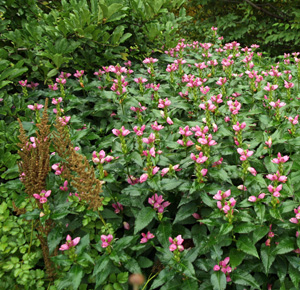
A fall blooming perennial, turtlehead gets its common name from the blossoms that resemble the shape of a turtle’s head with its mouth partly open. There are 6 species in the genus Chelone, all of which are native to North America. The genus name comes from Chelone, a nymph in Greek mythology who was punished for by the gods by turning her into a turtle. The plants are also occasionally referred to as shellflowers. They are typically found in bogs, swamps, along streams or in moist woods. Several of these herbaceous plants in the figwort family (Scrophulariaceae) are offered as ornamentals, or have been used to create garden hybrids.
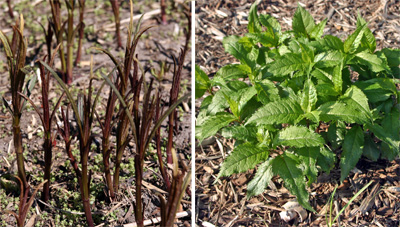
C. glabra (white turtlehead) was found along the eastern part of the continent from Newfoundland to Georgia and Alabama and is hardy in zones 3 to 8. C. obliqua (red turtlehead) has pink to nearly red flowers with a white or yellow beard. It occurs naturally from Minnesota to Florida and is hardy in zones 3-9. C. lyonii (pink turtlehead) is found in a restricted are in the mountains of central Appalachia that is hardy in zones 3-8. Most species are larval host plants for some species of checkerspot butterflies.
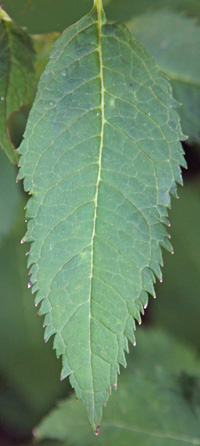
Chelone grows 12-60 inches tall (usually 2-3 feet for the garden cultivars) in a dense clump, spreading slowly over time from short rhizomes. The dark green foliage emerges in spring and remains attractive through the growing season. The opposite, often shiny leaves have a heavily toothed edge. Depending on the species, the broad to narrow leaves may have a tapering or rounded base with or without a petiole.
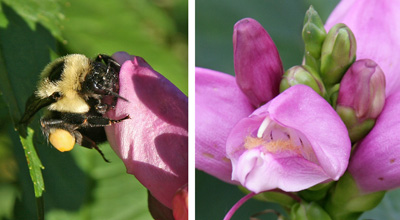
The two-lipped, snapdragon-like flowers, in shades of white, pink or red, appear from terminal spikes in late summer or early fall. Each inflated, tubular flower is irregular in shape, with the two upper petals fused into a hood-like structure and the other 3 petals forming a bearded, 3-lobed lower lip. They are attractive to hummingbirds, butterflies and bees.
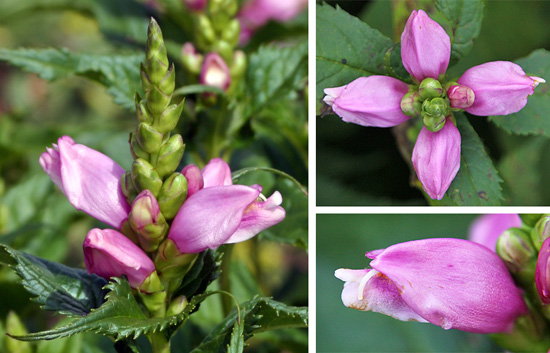
Pea-shaped seed pods may follow the flowers, starting out green and turning brown when mature, containing a number of medium brown seeds, each about 1/8 inch wide and pointed at the ends. Some types self seed readily, while others do not.
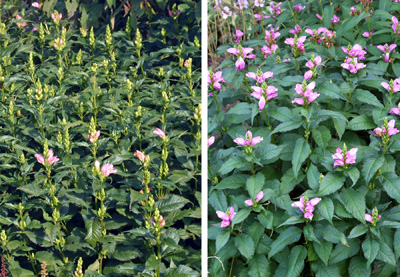
For most of the growing season, Chelone plants are unremarkable. Turtlehead really comes into its own late in the season, providing fall color in the perennial border or native garden. Grow it in masses with other perennials in the garden or naturalized area, especially in moist locations, such as along the edge of a water garden, pond or stream. It combines well with purple monkshood (Aconitum) and Shasta daisy ‘Becky’ and is a nice contrast with the dark foliage of Cotinus coggygria ‘Velvet Cloak’.
Turtlehead is best grown in full sun in the Midwest but tolerates some shade. It prefers rich, moist to wet soil, although most types tolerate drier soil once established. The stems can be pinched early in the year to produce a more compact plant (especially in shadier sites where the plants will grow taller), although staking is rarely required even when left to grow to its natural height. In some places it is favored by deer but not bothered by the animals in other locations – this likely varies by the different species and what other plants are available to the deer.
Chelone species can be propagated from seed, but the cultivars must be multiplied by division in spring. Seed is easily collected by collecting brown seed pods before they open. Seed should be sown on the surface (they require light for germination) and may require a period of chilling. Germination can take several months.

Many plants offered as C. obliqua may actually be hybrids of undetermined parentage. There are a number of named cultivars and hybrids including:
- C. glabra ‘Black Ace’ – has dark green foliage with a blackish tint and white flowers.
- C. lyonii ‘Hot Lips’ – an improved selection with wide, deep green foliage that emerges bronze-green, stems tinged red and deep rose-pink blossoms.
- C. obliqua ‘Alba’ – has white flowers.
– Susan Mahr, University of Wisconsin – Madison





 Alternatives to Lawn: Groundcovers
Alternatives to Lawn: Groundcovers Marigolds
Marigolds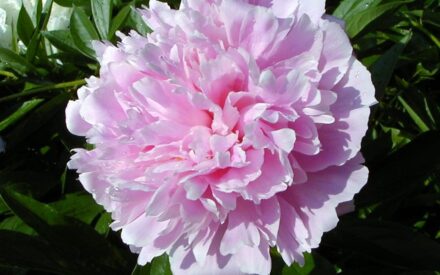 Peony
Peony Iris Severe Mosaic
Iris Severe Mosaic


